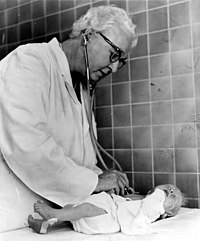
Photo from wikipedia
Introduction. A non-invasive and safe way to assess neurophysiological parameters in newborn infants is the evaluation of brainstem auditory evoked potentials (BAEPs). Objective. To assess the latencies and wave intervals… Click to show full abstract
Introduction. A non-invasive and safe way to assess neurophysiological parameters in newborn infants is the evaluation of brainstem auditory evoked potentials (BAEPs). Objective. To assess the latencies and wave intervals of BAEPs in healthy newborn infants born in a high-altitude area (Cusco, 3399 MASL). Population and methods. Cross-sectional and prospective study. Newborn infants younger than 14 days of age, discharged less than 7 days after birth, were assessed to determine BAEP values at intensities of 70 dB, 80 dB, and 90 dB. The study variables were gestational age, birth weight, and type of delivery. The median differences in wave latencies and intervals were estimated according to gestational age and birth weight. Results. A total of 96 newborn infants (17 preterm infants) were assessed. The median latencies of waves I-V at 90 dB were for wave I: 1.56 ms, wave II: 2,74 ms, wave III: 4.37 ms, wave IV: 5.62 ms, and wave V: 6.63 ms. The latency of wave I for 80 dB was 1.71 ms and for 70 dB, 1.88 ms. Wave intervals (I-III, III-V, I-V) were 2.8 ms, 2.2 ms, and 5.0 ms, respectively, without differences among intensities (p > 0.05). Prematurity and low birth weight were associated with a longer wave I latency (p < 0.05). Conclusions. Here we describe adjusted BAEP latency and interval values for newborn infants born at high altitude. At different sound intensities, we identified differences in wave latencies, but not in interwave intervals.
Journal Title: Archivos argentinos de pediatria
Year Published: 2023
Link to full text (if available)
Share on Social Media: Sign Up to like & get
recommendations!